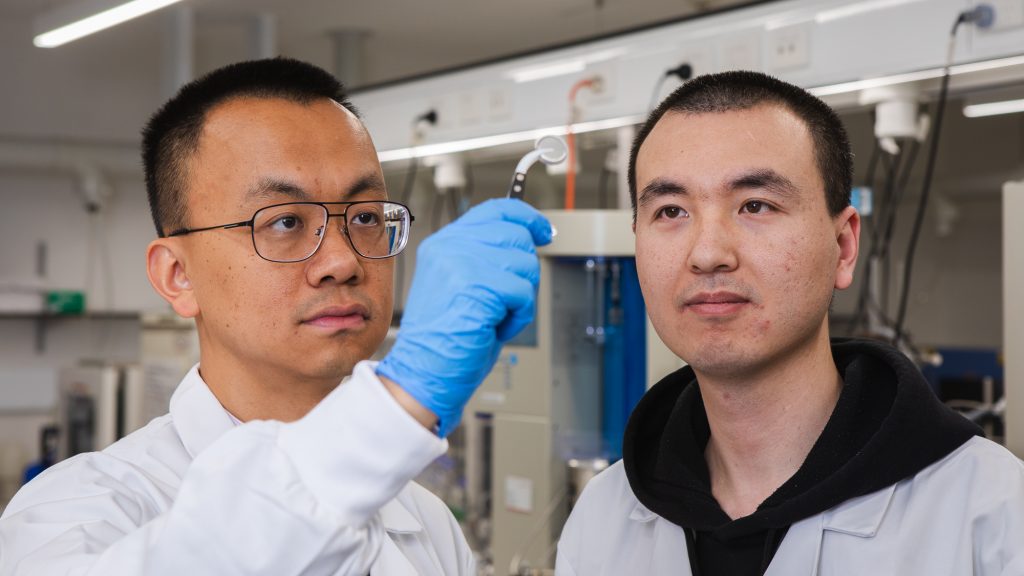Battery storage is set to become cheaper, safer and easier to manufacture thanks to advances made by a team of engineers from RMIT University.
Led by Distinguished Professor Tianyi Ma, RMIT researchers have developed a recyclable “water battery” – or aqueous electrolyte metal-ion battery – that is as energy-dense as a lead-acid battery and, unlike a lithium-ion battery, not flammable.
“We call them water batteries because we use water as an electrolyte instead of the organic electrolyte that is used in a lithium-ion battery,” Ma told create.
“The electrolyte we use is near-neutral water; it is not highly acidic water, so that means this water is safe. Even if the water electrolyte is leaking, it is still safe to our skin – to the human body – and is environmentally friendly.”
Ma clarified that batteries that use water as an electrolyte are not new; a lead-acid battery, he said, is a kind of water battery.
“But the disadvantage of the lead-acid battery is apparent from the name; it uses lead as the electrode material, which is a toxic heavy metal and not good for the environment or for human beings,” he explained.
“Also, the water electrolyte in a lead acid battery is highly acidic water – so it’s basically a sulfuric acid water solution.”
Cheap and cheerful
Ma’s battery, however, uses cheap transition metals such as zinc, nickel or iron for the electrodes.
“The components of the water battery are environmentally friendly,” he said.
“And the manufacturing process is cheap in comparison with lithium-ion batteries, which are widely used now in electric vehicles.”
That is because lithium-ion batteries require careful conditions during the manufacturing process. Using lithium for the electrode and a flammable organic solution as the electrolyte means the battery must be produced in a low-moisture and low-oxygen environment.
The water battery, on the other hand, can be manufactured on a workbench.
“You have no need to avoid moisture, water, oxygen, so the manufacturing process is simplified,” Ma said.
And when the water battery reaches the end of its life, the recycling process is far simpler than for a lithium-ion battery.

“You cannot expose the metal and electrolyte [of a lithium-ion battery], so if you want to recycle the lithium battery, you need very, very special conditions and expertise,” Ma said.
“But for water batteries … we break it apart on an open bench. It’s all safe because the metal is not explosive … and the electrolyte is not flammable.”
Right battery, right time
Despite the advantages offered by Ma’s water batteries, lithium-ion cells still retain some advantages, which is why he doesn’t foresee them being entirely replaced any time soon.
“For now, the energy density of the water battery is roughly one-third or one-fourth of that of the lithium-ion battery,” Ma acknowledged.
“Because the water is the electrolyte, you cannot go to a very high wattage, because the water will be broken apart into hydrogen and oxygen. The relatively lower wattage will cause a relatively lower energy density.”
Some of the continuing work on the battery, then, is on increasing its energy density.
“It’s all about the interaction between the electrode material and the electrolyte, so our innovation is to make a novel nanostructure [with] the material as the electrolyte, so we can [make] better contact with the electrolyte,” he said.
But energy density, he clarified, matters for some uses more than others. A battery designed to be used in an electric car, for instance, requires high energy density to minimise the weight the vehicle has to carry.
“In a lot of cases, we don’t need large energy density,” Ma said. “We need the battery to be safe and to be cheap, but energy density is not a key consideration.
“In cases like a solar farm, a wind farm – these large-scale renewable energy storage cases – they have plenty of space and land to store the batteries, so the energy density or the size of the batteries is not a consideration.”
Another example, he suggested, is using the batteries for smart devices or toys, where safety is paramount.
For now, Ma is investigating potential collaboration with industry partners who could help further develop the technology and eventually commercialise it.
“When we get more advanced nanotechnology, we may see one day that it can be competitive with lithium-ion batteries, but I’m not really, really sure of that,” he said.
“Water batteries will find [use] in energy storage, in small smart devices, wearable devices that we really need to be safe and cheap. Lithium batteries will be still dominating electric vehicles for many years.”
Engineers Australia Senior Policy Advisor Grant Watt said that Australia has “fantastic expertise” in battery technology.
“It is exciting to see the innovation and developments occurring when demand for batteries is projected to grow ninefold in the coming decade,” he said.
“Supply chains that stress sustainable sourcing of materials and integration of circular economy approaches can act as a competitive advantage for Australia. It is encouraging to see developments that improve safety and performance, such as aqueous energy storage.
“Research and development, commercialisation, industry engagement and investment are needed for Australia’s growing battery industry.”